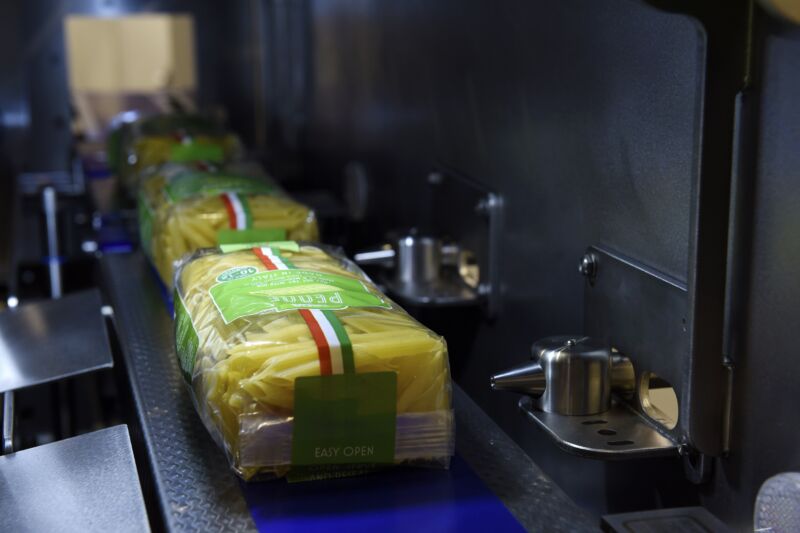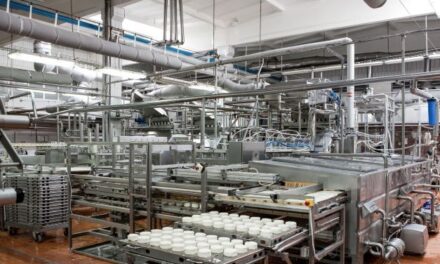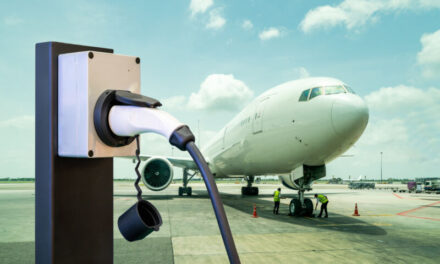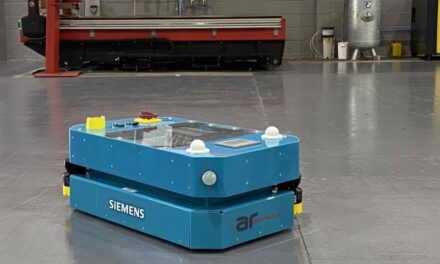Disrupted supply chains; CO2 shortages; labour challenges; energy price hikes; HGV driver issues; a lack of transport fuel… When the UK emerged from its pandemic-induced hibernation, few business owners could have predicted that such a wave of national crises would be there to greet them. Food and drink producers have been hit particularly hard, with headlines such as ‘Christmas dinner could be cancelled’, ‘CO2 supply shock could lead to food shortages in Britain’, and ‘Gas shortage hits UK food supplies’ illustrating the scale of the issues currently impacting the industry. Here, four leading equipment manufacturers outline the ways in which their solutions can help food and beverage businesses to remain resilient throughout 2022 and beyond…
Optimising CO2 use
One of the first casualties of record gas prices across Europe was a halt in production of carbon dioxide (CO2); a by-product of fertiliser production. Essential to food and drink manufacturing, CO2 is used in a variety of applications: to carbonate drinks; to stun animals before slaughter; to extend the shelf life of packaged products; to promote vegetable growth in greenhouses; and to keep food fresh during transport. This pause in production not only caused supply issues for some retailers but also saw a five-fold increase in the cost of CO2, from £200 to £1,000 per tonne.
As a result, food and drink producers have become increasingly vigilant over their use of CO2; it is now more business-critical than ever that the volume they do have is optimised, and that none is wasted. For AVE UK, this has translated into increased demand by water, beverage, beer and cider producers for its carbonation unit, which is manufactured by Priamo; like AVE, also part of the Della Toffola Group. Optimised for superior CO2 absorption, it accurately measures and doses the exact amount of CO2 required for every application, significantly reducing CO2 overdosing.
“Our inline carbonation unit comprises a chiller to promote better CO2 absorption, as well as a smart sensor linked to a feedback loop. This enables it to analyse in real time exactly how much CO2 it needs to dose to achieve the correct product specification,” explains Steve Bradley, Sales Director for AVE UK. “Not only is product accuracy and consistency guaranteed, but CO2 use is precision-optimised; drinks producers can be assured that every gram of their valuable gas is being used as intended.”
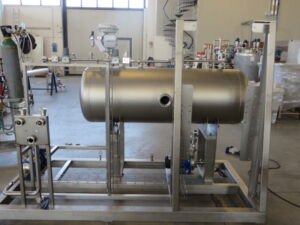
Supplied by AVE UK, the Priamo carbonation unit ensures correct dosage of valuable CO2
Cutting transport costs
AVE UK has also noticed an increase in enquiries for blow moulding machines. “With fuel price hikes and HGV driver shortages directly impacting manufacturers’ bottom line, it is vital that every journey is maximised,” says Steve. “Yet when drinks producers order multiple pallets of empty PET bottles, they are effectively paying to transport fresh air. It can be more cost effective to produce the bottles in-house, using a linear stretch injection blow moulding machine. The producer then only needs to pay for the transportation of the preforms; a single pallet can accommodate more than 25,000 preforms, compared to just 2,400 fully formed PET bottles. This not only equates to significant haulage savings and a reduction in transport emissions, but also frees up space in the warehouse.”
Mitigating against supply chain issues
The shortage of HGV drivers is just one of the causes of the supply chain crisis seen in recent months. Brexit and the pandemic have prompted many European workers to return home – figures from Indeed reveal the number of EU citizens looking for work in Britain has fallen by a third since Brexit – resulting in a shortfall of around 100,000 lorry drivers. High energy and transport costs, onerous Covid and Brexit-related border checks, and even individual events such as the Suez Canal blockage of March 2021 have also contributed to supply chain disruption, particularly affecting goods coming into the UK from Europe.
One obvious way to mitigate against this is to buy British. Metal detection specialist Fortress Technology manufactures its high-spec food inspection systems at its factory in Banbury, Oxfordshire and has seen enquiries increase due to its ability to fulfil orders more quickly than some foreign counterparts. “The Covid hiatus saw many projects put on hold,” says Phil Brown, Managing Director. “That pent-up demand is now translating into an influx of live enquiries for our food-grade x-ray and metal detection solutions, from companies that are looking for a swift turnaround. The fact that our equipment is British made, using local suppliers, mitigates against the supply chain fragility that is affecting distributors of European equipment. Certainly, our customers are relieved to learn that the long lead-times and import delays reported across the sector aren’t an issue when dealing with Fortress.”

Fortress Technology, which produces the award-winning Raptor Combi, has seen orders increase for its British-made inspection technology
Efficient energy use
Alongside supply chain interruptions, another challenge facing food and drink manufacturers is the increasing cost of energy; research firm Cornwall Insight is forecasting UK energy bills to rise by as much as 30% in 2022. Food and drink producers are therefore turning to energy-efficient solutions in greater numbers than ever before, in a bid to protect their profit margins as well as the planet. A main contributor to food producers’ energy costs are compressed air systems. Used to operate equipment such as pneumatic controls, air tools, pumps, valve actuators, robotics, pistons and larger-scale processes, compressed air typically accounts for up to 40% of a manufacturing facility’s total energy bill, while leak rates can exceed 50% on some systems.
Fortress’s Raptor Combi – an affordable metal detector and checkweighing conveyor system – has been designed with an innovative reject mechanism that has energy efficiency at its core. “Most reject mechanisms are pneumatic, running up high energy bills due to their continuous need for compressed air,” explains Phil. “By contrast, the Raptor Combi features an electric mechanism that only uses power when a reject is identified, saving £4,000 a year in energy costs when compared with compressed air alternatives.”
Focus on sustainability
Reducing compressed air consumption was also the driver behind the redesign of Brillopak’s UniPAKer robotic crate packing series, which now has vacuum generators built into the end-effector head. As a result, air is drawn into the centre of the head and fed to each of the five generators, to deliver a more consistent, targeted and faster airflow. Tested against early-generation end-effectors, Brillopak reports a 45% reduction in air use on the new-version UniPAKer when picking up and moving products of the same weight into retail crates.

Brillopak’s focus on sustainability has reduced the UniPAKer’s power consumption by 10%
Other sustainability improvements to the UniPAKer include: the use of servo motors that only require power when operational; reducing the weight of the end-effectors and other moving parts to decrease power requirement; and employing energy-efficient three-phase conveyor motors. “Our focus on sustainability has reduced the UniPAKer’s power consumption by 10%,” confirms David Jahn, Brillopak’s Managing Director. “Not only that, but it has also improved its performance, as the lighter, smaller end-effectors result in a faster pick speed while retaining presentation.”
Solving labour challenges
However, among the numerous challenges facing food producers, one stands out against the rest: labour. The NFU reports an estimated 500,000 vacancies in the food and drink sector resulting in crops being left to rot in the fields, abattoirs operating shorter weeks and meat and poultry processing sites cutting back production. Automation has long been heralded as part of the solution but until now, some manufacturers have been reluctant to invest in robotics.
For Stuart Coulton of Omron, this current crisis could be a tipping point: “Food manufacturing is in the grip of a severe labour shortage. By replacing repetitive, mundane tasks such as picking and placing, or palletising, with robots, companies can increase their overall efficiency and decrease production uncertainty – after all, a robot does not suffer from RSI or burnout and will never get sick. And with staffing vacancies an issue at every department across food manufacturing plants, production line employees can then be redeployed to other more business-critical areas.”

By replacing repetitive, mundane tasks such as picking and placing, or palletising, with robots, companies can increase their overall efficiency and decrease production uncertainty
Protection against unpredictability
If the last two years have taught us anything, it is to expect the unexpected. As Stuart explains, businesses that incorporate robotic solutions into their arsenal will also find themselves better able to cope with a rapidly changing economic landscape: “Robotics can help food and drink businesses mitigate against the extreme peaks and troughs in demand that we have witnessed in recent times. This is because, if correctly specified, robotic solutions provide a flexibility that cannot be matched with human labour. However, it is important to work with a reputable automation specialist to prevent against overspecification (meaning the solution will be energy inefficient and not cost-effective) or under-specification (which will prevent the end-user from being able to flex up to meet increased demand). A correctly-specified robotics solution will increase food producers’ agility and help to make the capacity curve more linear.”
